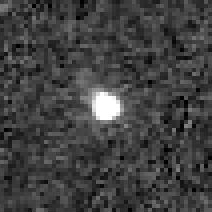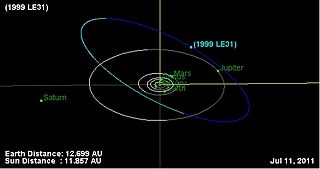Related Research Articles
Damocloids are a class of minor planets such as 5335 Damocles and 1996 PW that have Halley-type or long-period highly eccentric orbits typical of periodic comets such as Halley's Comet, but without showing a cometary coma or tail. David Jewitt defines a damocloid as an object with a Jupiter Tisserand invariant (TJ) of 2 or less, while Akimasa Nakamura defines this group with the following orbital elements:
20461 Dioretsa is a centaur and damocloid on a retrograde, cometary-like orbit from the outer Solar System. It was discovered on 8 June 1999, by members of the LINEAR team at the Lincoln Laboratory Experimental Test Site near Socorro, New Mexico, United States. The highly eccentric unusual object measures approximately 14 kilometers in diameter. It was named Dioretsa, the word "asteroid" spelled backwards.
(118228) 1996 TQ66 (provisional designation 1996 TQ66) is a resonant trans-Neptunian object of the plutino population in the Kuiper belt, located in the outermost region of the Solar System. It was discovered on 8 October 1996, by American astronomers Jun Chen, David Jewitt, Chad Trujillo and Jane Luu, using the UH88 telescope at the Mauna Kea Observatories, Hawaii. The very red object measures approximately 185 kilometers (110 miles) in diameter. As of 2021, it has not been named.
(79983) 1999 DF9 (provisional designation 1999 DF9) is a trans-Neptunian object of the Kuiper belt, classified as a non-resonant cubewano, that measures approximately 270 kilometers in diameter.

(40314) 1999 KR16 is a trans-Neptunian object on an eccentric orbit in the outermost region of the Solar System, approximately 254 kilometers (158 miles) in diameter. It was discovered on 16 May 1999, by French astronomer Audrey Delsanti and Oliver Hainaut at ESO's La Silla Observatory in northern Chile. The very reddish object is a dwarf planet candidate and has a rotation period of 11.7 hours.

(612093) 1999 LE31, prov. designation: 1999 LE31, is a centaur and damocloid on a retrograde and eccentric orbit from the outer region of the Solar System. It was first observed on 12 June 1999, by astronomers with the LINEAR program at the Lincoln Lab's ETS near Socorro, New Mexico, in the United States. The unusual object measures approximately 17 kilometers (11 miles) in diameter.
2010 TJ is a trans-Neptunian object from the scattered disc in the outermost region of the Solar System and measures approximately 460 kilometers in diameter. It was first observed by American astronomers David Rabinowitz, Megan Schwamb, and Suzanne Tourtellotte at ESO's La Silla Observatory in northern Chile on 2 October 2010.
2000 DG8 is a dark centaur and damocloid on a retrograde and highly eccentric orbit from the outer region of the Solar System. It was first observed on 25 February 2000, by astronomers with the LINEAR program at the Lincoln Lab's ETS near Socorro, New Mexico, United States. It has not been observed since 2001. The unusual object measures approximately 16 kilometers (9.9 miles) in diameter.

(82158) 2001 FP185 (provisional designation 2001 FP185) is a highly eccentric trans-Neptunian object from the scattered disc in the outermost part of the Solar System, approximately 330 kilometers in diameter. It was discovered on 26 March 2001, by American astronomer Marc Buie at Kitt Peak National Observatory in Arizona, United States.
2013 LA2 is a centaur and damocloid on a cometary-like and retrograde orbit from the outer Solar System, suggesting that it is an extinct comet. It was first observed on 1 June 2013 by astronomers with the Pan-STARRS survey at Haleakala Observatory, Hawaii, in the United States. The object measures approximately 1.8 kilometers (1.1 miles) in diameter. It holds the record for having the highest orbital inclination of any known minor planet.
(336756) 2010 NV1, prov. designation: 2010 NV1, is a highly eccentric planet crossing trans-Neptunian object, also classified as centaur and damocloid, approximately 52 kilometers (32 miles) in diameter. It is on a retrograde cometary orbit. It has a barycentric semi-major axis (average distance from the Sun) of approximately 286 AU.

(127546) 2002 XU93, provisional designation 2002 XU93, is a trans-Neptunian object and centaur on highly inclined and eccentric orbit in the outer region of the Solar System. It measures approximately 170 kilometers (110 mi) in diameter and is one of few objects with such an unusual orbit. It was discovered on 4 December 2002, by American astronomer Marc Buie at the Kitt Peak National Observatory in Arizona, United States.

2013 FS28 is an extreme trans-Neptunian object from the extended scattered disc on a highly eccentric orbit in the outermost region of the Solar System. It measures approximately 466 kilometers (290 miles) in diameter. The detached, extended scattered disc object belongs to the group of extreme trans-Neptunian objects. It was first observed on 16 March 2013, by American astronomers Scott Sheppard and Chad Trujillo at the Cerro Tololo Observatory in Chile.
2013 UH15 is an extreme trans-Neptunian object from the extended scattered disc in the outermost region of the Solar System, approximately 130 kilometers (81 miles) in diameter. It was first observed on 29 October 2013, by astronomers at the Las Campanas Observatory in the southern Atacama Desert of Chile. The detached extended scattered disc object (ESDO) is on a highly eccentric orbit and belongs to the extreme trans-Neptunian objects.
(457175) 2008 GO98, provisional designation 2008 GO98 with cometary number 362P, is a Jupiter family comet in a quasi-Hilda orbit within the outermost regions of the asteroid belt. It was discovered on 8 April 2008, by astronomers of the Spacewatch program at Kitt Peak National Observatory near Tucson, Arizona, in the United States. This presumably carbonaceous body has a diameter of approximately 15 kilometers (9 miles) and rotation period of 10.7 hours.
(342842) 2008 YB3, provisional designation: 2008 YB3, is a sizable centaur and retrograde damocloid from the outer Solar System, approximately 67 kilometers (42 miles) in diameter. It was discovered on 18 December 2008, by astronomers with the Siding Spring Survey at the Siding Spring Observatory in Australia. The minor planet was numbered in 2012 and has since not been named.
(468861) 2013 LU28, provisional designation 2013 LU28 is a highly eccentric trans-Neptunian object, retrograde centaur and damocloid from the outer regions of the Solar System. It was discovered on 8 June 2013 by astronomers with the Mount Lemmon Survey at the Mount Lemmon Observatory in Arizona, United States. The object is unlikely a dwarf planet as it measures approximately 110 kilometers (68 miles) in diameter. It was numbered in 2016 and has not been named since.
2011 MM4, provisional designation: 2011 MM4, is a sizable centaur and retrograde damocloid from the outer Solar System, approximately 64 kilometers (40 miles) in diameter. It was discovered on 24 June 2011, by astronomers with the Pan-STARRS 1 at the Haleakala Obs. in Hawaii.
In planetary science, the term unusual minor planet, or unusual object, is used for a minor planet that possesses an unusual physical or orbital characteristic. For the Minor Planet Center (MPC), which operates under the auspices of the International Astronomical Union, any non-classical main-belt asteroid, which account for the vast majority of all minor planets, is an unusual minor planet. These include the near-Earth objects and Trojans as well as the distant minor planets such as centaurs and trans-Neptunian objects. In a narrower sense, the term is used for a group of bodies – including main-belt asteroids, Mars-crossers, centaurs and otherwise non-classifiable minor planets – that show a high orbital eccentricity, typically above 0.5 and/or a perihelion of less than 6 AU. Similarly, an unusual asteroid (UA) is an inner Solar System object with a high eccentricity and/or inclination but with a perihelion larger than 1.3 AU, which does exclude the near-Earth objects.
(523706) 2014 HF200, provisional designation 2014 HF200, is a trans-Neptunian object on an eccentric orbit from the scattered disc, located in the outermost region of the Solar System. It was discovered on 20 May 2012, by astronomers with the Pan-STARRS survey at Haleakala Observatory, Hawaii, United States. The dwarf planet candidate measures approximately 300 kilometers (190 miles) in diameter.
References
- 1 2 3 4 5 "65407 (2002 RP120)". Minor Planet Center. Retrieved 20 November 2018.
- 1 2 3 4 5 6 "JPL Small-Body Database Browser: 65407 (2002 RP120)" (2004-06-22 last obs.). Jet Propulsion Laboratory . Retrieved 20 November 2018.
- 1 2 3 4 5 6 Johnston, Wm. Robert (30 December 2017). "List of Known Trans-Neptunian Objects". Johnston's Archive. Retrieved 1 March 2018.
- 1 2 "List Of Other Unusual Objects". Minor Planet Center. 14 November 2018. Retrieved 20 November 2018.
- 1 2 3 Fernández, Yanga R.; Jewitt, David C.; Sheppard, Scott S. (July 2005). "Albedos of Asteroids in Comet-Like Orbits". The Astronomical Journal. 130 (1): 308–318. Bibcode:2005AJ....130..308F. CiteSeerX 10.1.1.507.2206 . doi:10.1086/430802. S2CID 53642261.
- 1 2 Behrend, Raoul. "Asteroids and comets rotation curves – (65407)". Geneva Observatory. Retrieved 1 March 2018.
- ↑ "LCDB Data for (65407)". Asteroid Lightcurve Database (LCDB). Retrieved 1 March 2018.
- ↑ "MPC/MPO/MPS Archive". Minor Planet Center. Retrieved 20 November 2018.